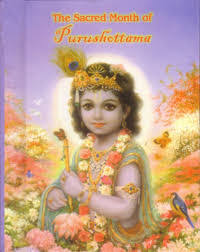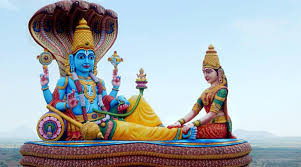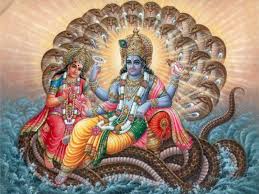COVID-19 claims the life of a world renowned spiritual leader but his legacy lives on. A video by Karuna Productions.
The post Bhakti Charu Swami: The Journey of a Modern-day Saint – Trailer appeared first on ISKCON News.
Websites from the ISKCON Universe
COVID-19 claims the life of a world renowned spiritual leader but his legacy lives on. A video by Karuna Productions.
The post Bhakti Charu Swami: The Journey of a Modern-day Saint – Trailer appeared first on ISKCON News.
Suppose someone we work with lies to us frequently, claiming either that they can do things they can’t or that they can’t do things they can. Being repeatedly misled by them, we will eventually realize they are unreliable. Won’t the same thing happen if we lie to ourselves? Suppose we need to follow a strict […]
The post Why Lying to Ourselves Is So Dangerous? appeared first on ISKCON News.
A video by Hare Krishna TV.
The post What Is Spiritual? appeared first on ISKCON News.
The Susquehanna Art Museum hosted members of Stress Free Harrisburg, the community arm of ISKCON Harrisburg at their monthly Art Moves Class. The collaboration was in conjunction with the museum’s “Creating Joy: Art Inspired by Music” exhibit. The Susquehanna Art Museum is interested in how artists find joy at the intersection of music and art. […]
The post Kirtan in the Museum – Harrisburg, Capital of Pennsylvania appeared first on ISKCON News.
With genuine spiritual advancement comes the capacity and capability to have friendly relationships with one and all. Equipped with spiritual vision that penetrates beyond externals, one remains undisturbed by annoying idiosyncrasies, ideological differences, unpredictable personalities, and sticky character traits. We’re able to see something deeper, see the spirit, the underlying sincerity. We can see the […]
The post Friendly Fire – Why Can’t We Be Friends With Everyone? appeared first on ISKCON News.
Recently I received an email from a devotee I had known in France in the 1970s. We haven’t had contact since then. It turns out that in the years since we were last together he discovered he is the grandchild of Jewish Polish survivors of Hitler’s concentration camps. Questions about statements from Srila Prabhupada concerning […]
The post What Did Prabhupada Mean In His Statements Concerning Hitler? appeared first on ISKCON News.
A video by I love Mayapur.
The post Monsoon in Mayapur! appeared first on ISKCON News.

A video by I love Mayapur.
Music video for Supersoul’s ‘Falling Apart’ from the ‘He Can Dance EP’.
The post Supersoul – Falling Apart appeared first on ISKCON News.
As soon as you press play on the title track of Supersoul’s new EP “He Can Dance,” and hear the irresistibly catchy melody, funky rhythms, brass, and smooth harmonies, you’re likely to find that you yourself, and possibly your whole family, can do nothing but dance. But the head-nodding grooves and immaculate radio-ready production aren’t […]
The post Australian Funk Rock Band Supersoul Releases Inspiring EP “He Can Dance” appeared first on ISKCON News.
A video by the GBC Strategic Planning Team.
The post Corporate Spiritual Responsibility – Stories From Business with a Purpose appeared first on ISKCON News.
His Holiness Chaitanya Chandra Charan Prabhu, a spiritual teacher for Russian-speaking devotees and a member of the GBC, and his wife Gourachandrika Devi, have been ill with coronavirus for a few days. They are already feeling better and recovering. They have been in a hospital in Almaty, Kazakhstan, for some time. Now their condition is […]
The post Russian Guru and GBC Chaitanya Chandra Charan Das Recovering from COVID-19 appeared first on ISKCON News.
Sodasha means 16 and Upacaras refers the articles offered to the Lord in worship. The upacharas are different aspects of service. In daily worship, one usually offers sixteen upacharas to the principal deity. In the Purusottama month, worship of Sri Sri Radha Krishna with 16 Upacaras is highly recommended. To enable to each and everyone […]
The post Sodasha Upacaras Puja daily offered to Sri Sri Radha Madhava! appeared first on Mayapur.com.

Sometimes Krsna and Balarama would play on Their flutes; sometimes They would throw ropes and stones devised for getting fruits from the trees, sometimes They would throw only stones, and sometimes, Their ankle bells tinkling, They would play soccer with fruits like bel and amalaki.
Read More...
Radha devi dasi, ISKCON’s GBC Vaishnavi Minister, recently announced the appointment of regional ministers in South Africa, the UK, Brazil and Mexico. Regional ministers serve as the liaisons for the Vaishnavi Ministry and develop programs for the care of Vaishnavis in their areas.
Read More...
Srila Prabhupada explained, “In Maharaja Yudhisthira’s time, the government was responsible to keep people peaceful, without any anxiety. That is government—without any anxiety. And now the government means full of anxieties. You do not sleep peacefully at night. . . . This is our position, full of anxieties. Even we cannot sleep peacefully at night. This government. And here you see, compare the government—no anxiety. No anxiety. Just compare. So what is the use of this rascal government?
The following is a video by His Holiness Bhakti Purushottama Swami speaking about the historic Grand Installation of the new Prabhupada Murti in the TOVP in February, 2021 to celebrate the 125th Appearance Anniversary Year of His Divine Grace Srila Prabhupada.
Donate today towards our worldwide combined guru dakshina campaign for Srila Prabhupada to help open the TOVP by sponsoring one or more of six kinds of abhishekas.
Go to the link below to sponsor an abhisheka: https://tovp.org/donate/prabhupada-murti-installation/

Lord Sri Krishna says: “For one who explains this supreme secret to the devotees, pure devotional service is guaranteed, and at the end he will come back to Me. There is no servant in this world more dear to Me than he, nor will there ever be one more dear.” (BG 18.68/69)
Read More...Podcast
Podcast Summary
Video:
The post The Monk’s Podcast 69 with Braja Bihari Prabhu – Guidance or Independence – How to make responsible decisions appeared first on The Spiritual Scientist.
Podcast
Video:
The post Reconciling science and scripture 2- QA appeared first on The Spiritual Scientist.


Once upon a time, by the arrangement of providence, an extra month came to this world. Every one took this month to be most inauspicious, and even saw it as a stool-like month. Just as one should not touch stool, this month was also seen as untouchable. It was constantly unprotected and blasphemed, and rejected by everyone as an improper time for any religious and auspicious activities.
Being so rejected by all human beings, and constantly hearing only bad words and blasphemy, the personality of this extra month became very sad. She came to Vaikuntha to explain her sorrowful situation to the Lord. Seeing Lord Vishnu on His simhasana, she fell down at His lotus feet in a mood of sorrow and grief. Tears were falling profusely from her eyes. She prayed to the Lord, “Oh ocean of mercy! I have come to You because I am helpless. I have been rejected and blasphemed by all people of the world. Please protect me; please show me Your mercy. Please don’t be indifferent towards me.”
Saying these words, the extra month [adhik maas] continued crying in front of Lord Vishnu and sat down before Him in a dejected mood. Seeing the humble and pitiable position of the extra month, Lord Vishnu became very merciful towards her. He told her, “Do not lament, I shall give you protection form all of your miseries. Please stop crying. It is not proper to lament after taking shelter of My lotus feet.”
Lord Vishnu told the extra month, “Oh child, your misery will be finished very soon. Get up and come with Me to Goloka Vrindavana, which is even unattainable to great yogis. Goloka is the abode of Lord Sri Krishna. Here Lord Sri Krishna is in His two handed form, surrounded by gopis and is enjoying His eternal pastimes. The Supreme Sri Krishna of Goloka will deliver you from all your miseries, please come with Me.” Then Lord Vishnu took Malamasa (the extra month) to Goloka by catching her by the hand.
Having reached the Supreme Abode, Lord Vishnu met Lord Sri Krishna who was surrounded by many devoted gopis. Lord Vishnu husband of Ramadevi, paid His obeisances to Lord Sri Krishna. Then He made the extra month also offer her obeisances at the lotus feet of Lord Sri Krishna, even though she was crying loudly. Immediately Sri Krishna asked, “Why is she crying? She is in Goloka Vrindavana, why is she crying?”
Hearing these words form Lord Sri Krishna, Lord Vishnu got up from His seat and started explaining the miserable condition of the extra month. He begged Him to please protect his unprotected month. “There is no one except You Lord Krishna, who can save this extra month from her hellish condition and give her full protection.” Having said these words, Lord Vishnu remained standing in front of Lord Krishna with folded hands.
Purushottama Sri Krishna said, “Oh Vishnu, you have done a very great deed by bringing this extra month to Me. You will become even more famous for performing this act. Because You have accepted this Malamasa, I will also accept her. I shall make this poor extra month just like Me in quality, fame opulence, realization, success, and in giving benediction to the devotees. This month will become equally potent to Me. I am bestowing all of My divine qualities in this abused month. Named after Me, this month will be famous as Purushottama month in this world.
“Oh Janardana, now that she has imbued My qualities, I Myself will become the husband and protector of this Purushottama month. And being equal to Me, this month will be the master of all other months. Now this month will become worshipable by one and all. Everyone should pay their obeisances to her, everyone should worship her. This month is equally as powerful as Me to give any type of benediction to its observer. The worshiper of this month will be able to burn all this past sinful reactions to ashes, and after enjoying a blissful life in the material realm, he will return back to Godhead.
Purushottama Maas comes every three years and is an extra month in the Vedic calendar that is inserted to keep the lunar and solar calendars aligned. It is during this time that devotional practices and vows are highly beneficial.
Lord Sri Krishna said (Padma Purana):
“All human beings should perform some devotional service in this Purushottama month by:


Rosedale, Toronto
This Is A Good One
The following is a knee-slapper sent by Bhakti Purusottama Swami from Orissa, India.
An Indian dies and goes to hell. There he finds that there is a different hell for each country. He goes first to the German hell and asks "What do they do here?" He is told "First they put you in an electric chair for an hour. Then they lay you on a bed of nails for another hour. Then the German devil comes in and whips you for the rest of the day."
The man does not like the sound of that at all, so he moves on. He checks out the USA hell as well as the Russian hell and many more. He discovers that they are all more or less the same as the German hell. Then he comes to the Indian hell and finds that there is a very long line of people waiting to get in.
Amazed he asks "What do they do here?"
He is told "First they put you in an electric chair for an hour. Then they lay you on a bed of nails for another hour. Then the Indian devil comes in and whips you for the rest of the day."
“But that is exactly the same as all the other hells - why are there so many people waiting to get in?”
"Because the maintenance is so bad that the electric chair does not work, someone has stolen all the nails from the bed, and the devil is a former Government servant, so he comes in, signs the register and then goes to the cafeteria."
May the Source be with you!
3 km
Queen’s Park, Toronto
Letting Go!
It always pays off. This walking I do, to a nearby park, in any direction, almost each day, gets attention by some individual and leads to a spontaneously established friendship.
Today I made my way southbound to Queen’s Park to meet a newly made compadre, Saurav, where we would be going over a discussion on chapter 1 of The Gita. He tells me he has accepted me as his teacher and also admitted it’s hard for him to spark an interest in spiritual talk with his buddies. With me it’s 90% all about that.
Our reading over the verses of chapter 1 went well. It is one of the more compelling segments of the Gita. In our reading of the 40 plus verses I suggested he go at it a little more dramatically. I thought it suited his nature. After all, he is a very expressive type of person.
“Saurav, A little more oomph!” I am implied.
We were nearing the end of our verse recitation and discussion when a young Asian woman approached us. We were sitting on a park bench facing in the direction of an impressive statue of King Edward VII on a horse. She identified herself as Audrey and asked if she could join us. Naturally our answer was “Yes.” She pulled out of her bag a book authored by David Hawkins called, “Letting Go” and she admitted it’s helping her overcome some challenges in life.
The term “letting go” is perfect for describing the essential message behind The Gita, so we discussed that with Audrey, who’s such a pleasant person. We were a buzzed-up trio from here on until departing time. It was very fulfilling for all of us.
May the Source be with you!
3 km
 On June 21, 1973, in Mayapur, Srila Prabhupada spoke on Srimad-Bhagavatam 1.10.6:
On June 21, 1973, in Mayapur, Srila Prabhupada spoke on Srimad-Bhagavatam 1.10.6:
nadhayo vyadhayah klesa
daiva-bhutatma-hetavah
ajata-satrav abhavan
jantunam rajni karhicit
“Due to the king’s having no enemy, the living beings were not at any time disturbed by mental agonies, diseases, or excessive heat or cold.”
Srila Prabhupada explained, “In Maharaja Yudhisthira’s time, the government was responsible to keep people peaceful, without any anxiety. That is government—without any anxiety. And now the government means full of anxieties. You do not sleep peacefully at night. . . . This is our position, full of anxieties. Even we cannot sleep peacefully at night. This government. And here you see, compare the government—no anxiety. No anxiety. Just compare. So what is the use of this rascal government?
“The rascal government must be there because we are rascals. You cannot complain against the government, because we select. It is the days of democracy. We elect our representative. So why should you blame the government? You have created the government. You have sent your representative, a rascal, another big rascal. You are rascal, and another big rascal you have voted; so how you can expect good government? You send only big rascals. That’s all.
“So there cannot be. That is stated in the Srimad-Bhagavatam, that in the Kali-yuga all the people will be rascals, sudras. Simply by manipulation if one gets vote, he captures the governmental power. Sudra. He’s a sudra. He is not a kshatriya like Maharaja Yudhisthira, trained-up kshatriya. He is a rascal, third-class man, fourth-class man. He gets the vote, and we give vote. So how we can be happy? How we can be carefree or anxiety-free or disease-free? It is not possible.
“Therefore if the people in general become Krishna conscious, become trained up in Krishna consciousness, understand the value of life, how to live, then they can send good representative, Krishna conscious man. Then the government will be nice.”
Hare Krishna.
Yours in service,
Giriraj Swami

One of the gopis once playfully warned her friend about the power of Krsna’s attraction: “My dear friend, if you are at all attached to your worldly friends and relatives, do not look at the smiling face of Lord Govinda as He stands on the bank of the Yamuna at Kesi-ghata.
Read More...
Padmavati Devi Dasi, during Harinama asks people in the street to chant twice the Hare Krishna maha-mantra for love and peace in the world. So many beautiful people are reciprocating and willing to chant for the first time!
Read More...